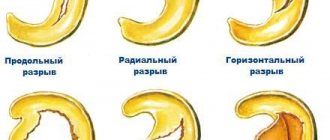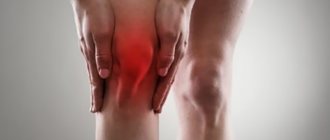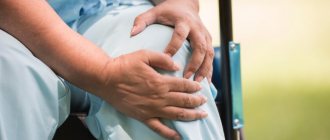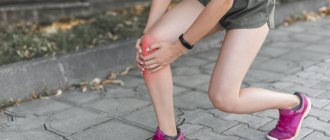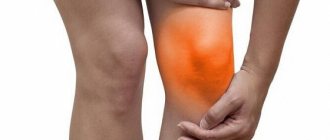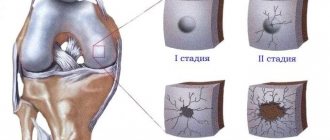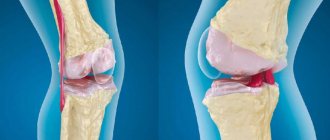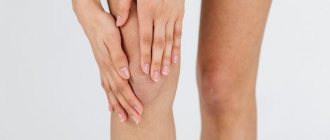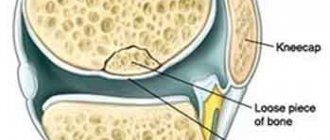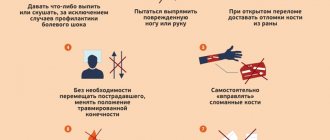Therapeutic exercises for arthrosis of the knee joint are prescribed to strengthen articular structures, prevent the formation of contractures and normalize the functioning of the joint. To ensure that physical exercise brings maximum benefits, it is recommended to visit the gym and exercise under the supervision of an instructor. However, you can also train at home, having previously agreed on the training complex with your doctor.
The benefits of exercise therapy
Osteoarthritis of the knee joint is a disease of a degenerative-dystrophic nature, with the progression of which soft and bone joint structures are destroyed. If treatment is not started in a timely manner for diseases of this nature, the knees become deformed and the legs cease to function normally. With the development of degree 3, a person turns into a disabled person, since the joint becomes completely immobilized.
Therapeutic exercise for arthrosis of the knee joint helps to stop the progression of the disease, and regular training will make it possible to achieve the following results:
- normalize blood circulation and nutrition of affected joint tissues;
- strengthen the muscle-tendon system;
- prevent pathology from spreading and affecting healthy joint structures;
- reduce the discomfort that disturbs day and night with deforming arthrosis.
Exercises for a diagnosis of arthrosis are simple, they are also well suited for older people, who often have such a diagnosis. It is important to do knee exercises carefully, avoiding rough and sudden movements. Training is necessary during postoperative rehabilitation.
Indications, contraindications
Performing exercises is indicated when the mobility of the joint is limited. Joint exercises for knee arthrosis are indicated for patients at different stages of the pathology, as well as during the recovery period after surgical treatment. Exercises are recommended for the following disorders:
- limitation of limb mobility;
- formation of contractures;
- muscular and ligamentous tendon dystrophy.
However, physical therapy is not always beneficial for sore joints.
They refuse to practice in the following conditions:
- exacerbation of chronic pathologies;
- blood pressure surges;
- increase in temperature indicators;
- formation of tumors of various etiologies;
- cardiovascular pathologies.
The basic principle of physical activity for knee arthrosis
As a rule, at the initial stage of treatment of arthrosis or osteoarthritis, there is a limitation of mobility - minimal or more significant. Therefore, along with other therapeutic and preventive measures, it is necessary to work on lost movements.
For example, you notice that discomfort occurs when bending your knee. This means that you need to work on this particular movement, but it should be low-amplitude (no more than 1 cm), oscillatory, and as long as possible. If after training the knee joint begins to move in this direction a little more, the discomfort has decreased - you did everything right. You should not be afraid of short-term pain if it is followed by improvement.
Low-amplitude movements can do wonders for joints if performed regularly
Pros and cons of gymnastics for arthrosis of the knee joint
Exercise therapy for deforming arthrosis has the following advantages:
- The progression of the disease is stopped.
- When performed regularly, it is possible to prolong remission.
- Metabolism in the body is normalized, which is useful for losing weight and bringing weight back to normal.
- Thanks to the systematic implementation of exercises, the need for surgical treatment disappears.
The disadvantages of exercise therapy are conditional and incomparable with the obtained effect:
- At the beginning of the treatment course, a person may experience pain in the joints.
- It is important to train daily, without missing a single lesson.
- Changing the training complex on your own without consulting a doctor is contraindicated.
- In the first stages you will have to endure pain, but the discomfort will quickly pass: the joint will fully develop.
An unconventional approach to exercise therapy: shiatsu for arthrosis
Shiatsu is a healing and healing system that is based on healing pressures. Practitioners are convinced that this is the easiest way to restore mobility to a damaged joint. The principle is simple: while performing exercises, you must gently press on the sore spot and do not release the pressure during physical activity.
Is it worth experimenting? Yes, if you have become acquainted with the theoretical foundations of this technique, talked with a specialist and are confident that you will not harm yourself. Otherwise, treatment of arthrosis or osteoarthritis may be delayed, since the disease will worsen due to improper impact on the damaged joint.
If, in addition to physical education, you add these 5 products to your diet, the likelihood of successfully fighting arthrosis, according to some experts, increases significantly. What are these products?
General rules
In order for therapeutic exercises for arthrosis of the knee joint to bring maximum benefit, it is important to adhere to these simple rules:
- Gymnastics for elderly and young people should not cause deterioration. If you feel pain during training, you should inform your doctor about it and, together with him, adjust the activity.
- It is important to practice daily, without skipping.
- Perform movements carefully, smoothly, slowly.
- After exercise therapy, you should rest and relax your muscles.
What exercises should I do?
For the treatment of arthrosis, many proprietary techniques have been developed aimed at restoring and normalizing the functioning of the affected joints.
Dr. Popov’s training exercises are popular, which includes the following exercises:
- Dangling your legs while sitting on a chair is beneficial for your joints.
- Lie on your back, bending and unbending your knees, and perform sliding movements.
- Sitting on a chair, perform rocking movements, simulating the work of a pendulum.
- Lean your back against the wall, slowly squat, and then rise.
- Leaning against the support, move the limb to the side, bend it at the joint, straighten it and return to the starting position.
- If the disease does not progress and the patient’s condition is stable, it is recommended to use an elliptical trainer for greater effect from training.
A unique training complex based on the Ivashkevich method with a belt trainer will help you quickly develop the knee joint and return it to its usual functionality. It is useful to do the following exercises for arthrosis:
- While sitting on a chair, place your limbs between a belt exercise machine folded into a loop. Straining the muscles of your legs and knees, try to stretch the clamp as much as possible.
- In the same position, perform the “bicycle” exercise, weighting the movements with a training belt. This activity is useful for strengthening the quadriceps muscle.
Other useful complexes
If your knees hurt. Exercises for arthrosis and pain in the knee joint
Not every movement is beneficial when your joints hurt. But there are exercises that have a therapeutic and healing effect on the knee joints, serve as an excellent prevention of osteoarthritis and arthritis (inflammation) of the knee, and are used in rehabilitation after injuries and operations on the knee joint.
Special offer. Consultation + diagnostics using the method of applied kinesiology – 1000 rubles.
Call, write. Tel.: (843) 570-55-25 , WhatsApp: 79655968085 or VKontakte group .
How do exercises heal joints?
The osteochondral tissue of the joint does not have its own vessels, so it receives nutrients from the bloodstream in nearby muscles. With movement and muscle contraction, the joint begins to actively wash, moisturize, its nutrition increases, pain and swelling in the joint decrease (due to the outflow of inflammatory fluid). And all this without the use of anti-inflammatory drugs.
The production of a sufficient amount of joint fluid (“lubrication” of the joint) depends on the active work of the muscles and ligaments of the joint itself. The muscles work - the joint itself is “lubricated”.
What muscles supply the knee joint? The function of muscle pumps for the knee is performed by the thigh muscles: quadriceps and biceps femoris (front and back surfaces), especially the quadriceps. By forcing the large thigh muscles to work fully, we can restore the main sources of blood supply to the knee joint.
What is the easiest way to get your thigh muscles to work? Using the well-known basic exercise - squats. Squats, as well as hill climbs, serve as the best prevention of arthrosis and arthritis of the knee joint. However, if the knee already hurts, the joint is inflamed, axial load on it is not desirable
. What to do?
First solution: find a compromise option. Half squat.
If your knees hurt, you can try doing only half squats - squats with a small amplitude, if necessary, supported by a wall or chair. And most importantly, strictly observing the technique of performing squats
. The center of gravity should not shift to your knees. To do this, you need to lower yourself down as if you were going to sit down on an imaginary chair that is located behind you. The pelvis is retracted. Don't lower your hips below parallel with the floor. When squatting, watch your knees; they should not go forward beyond your toes. Also make sure that there is no rotation of the knee outward or inward. The knee and toe are in the same plane.
By squatting in this way, we transfer the center of gravity to the quadriceps femoris muscle - which is what we need, while minimally loading the sore knee joints.
Second solution. Exercises for the knee joint using a shock absorber
A special device - a rubber (silicone) shock absorber for fitness, also known as an expander for kinesitherapy - allows you to effectively load the thigh muscles, both quadriceps and biceps. With this fitness equipment, you can perform many exercises for your legs and back at home without axial load on your joints.
The shock absorber is an elastic cord with grips on two or three ends. You can buy it in sports stores.
As an alternative, you can use elastic fitness bands, an expander - a rubber shock absorber with handles (handles), a tubular shock absorber with cuffs.
When choosing a shock absorber, please note that there are models that indicate the degree of tightness: light, medium, hard. For leg training, the medium option is usually optimal. The main thing is that when performing exercises, tension is felt in the leg muscles and the shock absorber does not sag
. If necessary, you can adjust the load by tightening the shock absorber several turns, or use two shock absorbers connected together.
Important! the rubber shock absorber should be attached to the lower part of the shin with a loop, preferably on a thick sock. The other end is attached to a stationary heavy support, such as the leg of a sofa, bed or cabinet. But it is better to screw some kind of hinge-type brackets at different heights into the load-bearing wall of the house or room, to which the free end of the shock absorber could be secured for performing exercises on the floor or on a bench.
Therapeutic exercises for the knee joint
So, the treatment complex at home consists of strength and decompression exercises.
Strength exercises are aimed at working the muscle “pumps” - the thighs, developing strength and elasticity in the muscles surrounding the knee joint. Decompression, which relieves stress from the joints, improves microcirculation in the joint and helps remove inflammatory fluid from it.
When performing exercises, do not forget to breathe. During the power phase (bending, pulling), exhale well. The minimum number of classes per week is three. The duration of the lesson is at least 20 minutes and no more than an hour. With each week and month, try to increase the number of exercises you perform over a certain period of time.
Exercises must be performed with 15–20 repetitions in one series.
Exercises 1
Lying on your chest, pull the shock absorber with your foot until the leg is fully bent at the knee joint. The main advantage of the exercise is decompression of the surfaces of the knee joint. It helps to stretch the spasmodic muscles of the popliteal area and improve the drainage function of the thigh muscles, and get rid of swelling in the knee joint caused by injury.
Recommended for bursitis of the knee joint, after removal of the menisci or transplantation of the cruciate ligaments of the knee joint.
Exercises 2
Extension of the leg at the knee joint with the traction of the rubber shock absorber out of position. If one joint is damaged, then you can perform this exercise from I.P. standing on your healthy leg. The leg with the shock absorber is slightly moved back and up (approximately 30 degrees), while the heel with the shock absorber is raised above the floor as much as possible, but without tilting the torso forward.
The exercise is performed by straightening the leg at the knee joint until it is fully straightened. When performing this exercise, you may experience unpleasant sensations in the musculo-ligamentous apparatus of the knee. You don't need to pay much attention to this. The exercise is considered correctly performed if, when extending the leg, the quadriceps femoris (anterior muscle) is fully tense. The degree of tension of the rubber shock absorber is determined in the same way as in exercise No. 1. When extending your leg, try not to touch the floor with your toe.
Exercises 3
Bending the leg at the knee joint with shock absorber traction from a standing position. The shock absorber is attached to the lower part of the shin, its other end is fixed to the free hand. Bend your leg at the knee joint, trying to touch your buttock with your heel. Keep your knee in one position, without moving it away from the vertical line of your body. When bending, blood circulation in the popliteal area improves. When lowering the leg, the muscles of the thigh and lower leg are stretched with complete unloading of the thigh and lower leg. Performed alternately: first with one leg, then the other.
The exercise is recommended not only for arthritis and arthrosis of the joint, but also for bursitis, tendovaginitis, after surgery on the ligamentous apparatus of the joint, as well as meniscus injuries. In addition, strength exercises for hip flexion and extension can be used in the gym to treat knee pain, recover from injuries and surgeries.
Exercises 4
We sit sideways to a fixed support, behind which one end of a rubber shock absorber is fixed. The other end is attached to the lower part of the lower leg or foot from the side of the fixed support, bring the leg with a rubber shock absorber, then move it to the side as much as possible, while the leg is straight, the other can be bent. The greater the angle of abduction of the leg to the side, the greater the effect this exercise gives.
The force can be reduced or increased by changing the initial position, being closer or further from the shock absorber mounting point.
This exercise also has a great rehabilitation effect for damaged menisci or in the period after surgery to remove the menisci.
Exercises 5
Similar to the previous one, but in this version the leg is moved to the side as much as possible.
Explanations: these two exercises for the adductor and abductor muscles of the hip are so effective that they can replace surgery to remove the menisci if they are destroyed. In addition, it is recommended to massage the muscles in the area of the lateral surfaces of the joint through the pain, applying a cold compress afterwards.
Exercises 6
Bench press with legs. This exercise is performed after the effect of flexion and extension of the leg at the knee joint is achieved.
The bending of the leg at the knee joint should be deeper with each subsequent session, and the straightening of the leg should be complete.
Second group of exercises
Decompression exercises. Necessary to perform the drainage function of joints, that is, to pump out inflammatory fluid from the joint and enhance its microcirculation. Usually performed after strength exercises or in alternation with them.
Exercises 7
From I.P. on all fours (arms and legs) a shock absorber is fixed to the sore leg behind the lower part of the shin. The other end of the shock absorber is fixed to a fixed support at different heights (the higher the better). The shock absorber should be as taut as a tow rope. The movement is carried out by pulling the hips forward, quite sharply, like hitting a ball. The head should not be lowered. You can complicate this exercise by increasing the distance between the starting position and the fixed support or the number of shock absorbers fixed to the leg.
Explanation: the exercise helps restore the anthropometric length of the muscles of the thigh and lower leg in order to eliminate their rigidity (shortening). Pain during exercise disappears on the 3rd–4th day after the start of exercise.
Exercises 8
Starting position: lying on your back, with your feet towards a stationary support at the maximum possible distance from it. The affected leg is connected to a fixed support through a rubber shock absorber. Either with one or the other hand you need to hold on to a support, for example, the leg of a sofa. Pull the thigh toward the body from the position of an extended leg until the thigh touches the lower abdomen. By performing this exercise, we stretch the front of the thigh, through which the quadriceps femoris muscles grasp and fix the kneecap. This is one of the best exercises to treat patellar bursitis. It also helps tremendously in the rehabilitation of the leg after removal of the menisci and surgery on the cruciate ligaments (in particular, the anterior one).
Exercise 9
Starting position lying on your side. Perform the leg pull in such a way that the leg is completely twisted at the hip joint until the knee touches the floor in front of the stomach. When the leg returns to its original position, it unwinds, while the heel looks strictly at the floor.
Features of the exercise: when rotating the leg in the hip joint, crunching, cracking and even mild shooting pains are possible. Since the exercise is decompressive in nature, such sounds may indicate neglect of the ligamentous apparatus in terms of hypokinesia, which means this is a normal phenomenon.
You can get detailed information on treatment and health improvement at the Kazan Kinesitherapy Center by calling: (843) 570-55-25 . Call! Our specialists will be happy to answer all your questions.
You can ask questions and leave comments in our VKontakte group.
Even more useful articles in Yandex Zen:
Follow us on Instagram:
Don't miss out on the fun! Subscribe to our news:
Subscribe to news from the Kazan Kinesitherapy Center
Center promotions, therapeutic exercises and useful tips from our specialists on how to independently maintain the health of your joints and spine without medications
Similar articles:
Osteoarthritis of the knee joint
Osteoarthritis affects 98 percent of the adult population. How to cure without drugs?
Prevention of arthrosis
The “bicycle” exercise is performed while lying on your back.
An effective technique based on the teachings of Taijiquan was developed by Dr. Kotlyar. When performing training, the amplitude of movements is minimal; muscles are warmed up through static exercises. The exercises developed by Kotlyar for arthrosis of the knee joint include the following exercises:
- Sitting on the floor, rub your sore joints with your hands.
- Perform vibration movements with straight legs, concentrating the load on the knees.
- Take the “Turkish” position. Pat the knuckles with the back of your hand.
- Lie on your back, raise your limbs bent at the knees, imitate riding a bicycle.
What is important to know
To avoid complications and improve charging efficiency, you need to know:
- hypertension, hyperthermia, hernias are contraindications to exercise therapy, and confirmed ankylosis is also the basis for surgical intervention;
- Exercises for knee joints with arthrosis are carried out daily, without skipping, as prescribed by the doctor. The purpose of morning exercises is to prepare the joints for functioning throughout the day, since the pathology is characterized by severe pain and morning stiffness in the legs;
- always warm up the knee area, do not perform spontaneous, sudden loads;
- the number of approaches and repetitions is determined by the degree of complexity of the movements performed and depends on the level of physical fitness of the patient;
- the pain that occurs during physical exercise is eliminated on its own in 90% of cases, immediately after the end of the warm-up. At the very beginning of the exercise therapy course, patients need pain relief in order to improve their well-being during the day and not lose motivation for further training;
- In addition, you should wear comfortable, shock-absorbing shoes that do not cause slipping.
When planning the volume of training and the duration of the exercise therapy course, the specialist takes into account the degree of arthrosis, since at stage 3 of the pathology, exercise for the knee joints is an unjustified approach. Treatment of advanced disease is possible only with the help of surgery.
Exercise therapy complex according to Evdokimenko
Gymnastics for the knee joints, developed by rheumatologist Pavel Evdokimenok, helps stop degenerative processes and restore damaged structures. The basic complex includes the following exercises:
- Dr. Evdokimenko recommends performing the “Plank”, leaning on your elbows and toes.
- Lying on the surface, raise the limb, slightly bending the knee, stay in the position for 25-30 seconds, then change legs.
- Lie on your stomach, rest your hands on the floor. Raise your straight leg slightly, performing pulling movements with your foot back and forth. In the same position, leaning on your elbows and the front of your soles, perform the “plank” exercise.
- Standing straight and leaning against the wall, first rise on your toes 30 times, then on your heels the same amount, concentrating the load in the calf muscles.
- Turn your feet inward and walk on the floor for 1 minute. Repeat the exercise, but with your feet facing outward.
- After all the exercises, it is recommended to give yourself a relaxing massage of the lower limbs and knee joints.
What gymnastic exercises are prohibited?
Exercise therapy for arthrosis of the knee joint is not always beneficial. If you do not control the load on the joint and ignore contraindications, you can harm your health and worsen your condition. If you are diagnosed with arthrosis, you need to stop fast cycling, skiing, skating, and skateboarding. Running is also prohibited, because in this case the load on the joint is maximum, which intensifies the degeneration process. It is recommended to exclude activities that include jumping, full squats, and sudden lunges. It is worth giving up contact, active and traumatic sports, such as football, volleyball, basketball, hockey.
What should I do?
Orthopedic rheumatologists take different approaches and give completely different recommendations to patients. Some people advise losing weight or giving up calcium-rich foods. More progressive doctors introduce the Noltrex intra-articular injection technique, after a course of which mobility is restored and pain goes away.
With any approach, it is important to ensure adequate mobility of the joint. That is why a variety of physical activity, within reasonable limits, is considered the best prevention of arthrosis, even after treatment or other intervention. Movement is life. Move, pay attention to your joints - live with pleasure!

